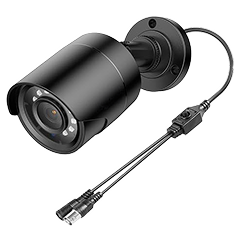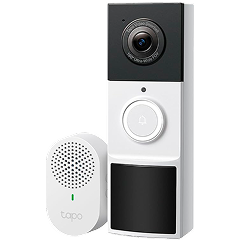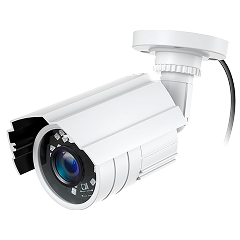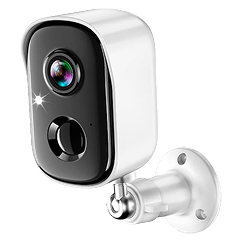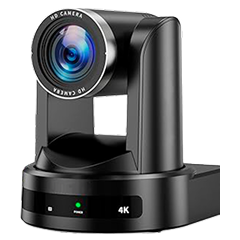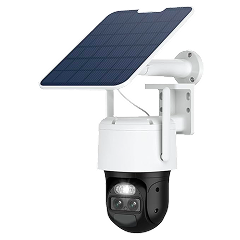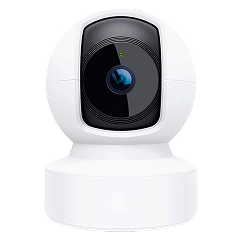After installing Ring cameras at two different properties and researching my planned UniFi upgrade, I’ve spent considerable time evaluating when PTZ cameras make sense versus fixed installations. My engineering background taught me to analyze trade-offs systematically, and PTZ cameras present fascinating ones.
While I chose fixed cameras for my own setup (3 outdoor Ring cameras plus a doorbell at my current home and battery-powered units with solar panels at my previous property), I recognize that PTZ cameras solve specific surveillance problems that no amount of fixed camera positioning can address.
You’d think one PTZ camera could replace multiple fixed units for monitoring wide areas or following moving subjects, but that’s where most people get tripped up. These cameras can’t be everywhere at once.
I’ll walk you through the specs that actually matter when shopping for PTZ cameras: how far the zoom really works, whether the motors respond fast enough, if auto-tracking delivers on its promises, and which components break first. I’ll draw from my Ring system experience and UniFi research to explain when PTZ capabilities justify their complexity and cost versus simply adding more strategically placed fixed cameras.
Optical Zoom Performance: The Primary PTZ Advantage
The reason most people consider PTZ cameras over fixed units comes down to one feature: optical zoom capability.
30x+ vs 20x vs 12x Zoom: Real-World Identification Distances
Higher optical zoom numbers sound impressive until you test them in actual conditions. A 30x optical zoom lets you read license plates clearly at 100+ feet, while a 20x zoom drops that effective range to about 60-70 feet. Anything below 12x optical zoom defeats the purpose of choosing PTZ over fixed cameras; you’re paying for motors and complexity without gaining meaningful identification range. I’ve seen demos where 30x zoom captured facial details at distances that would require three or four fixed Ring cameras to cover the same area effectively.
Zoom vs Image Quality Trade-offs
Here’s what camera companies won’t tell you about maximum zoom performance:
- Image stabilization becomes critical above 20x; any vibration turns footage into unusable blur
- Compression artifacts multiply at high zoom levels, especially with H.264 encoding
- Autofocus struggles in low light when zoomed beyond 15x magnification
- Digital noise increases dramatically at maximum optical zoom settings
- Wind movement of the camera mount destroys image quality at high magnification
These limitations mean your “30x zoom” camera might only deliver usable footage at 20x in real-world conditions.
Optical vs Digital Zoom Limitations
When you twist the zoom ring on optical zoom, actual lens elements physically move to magnify what you’re looking at. Digital zoom? The camera just crops a section of the sensor and stretches it to fill your screen. The same thing happens when you zoom into any photo on your phone and watch it turn into a blocky mess.
Most PTZ cameras combine both, but anything beyond the optical zoom specification becomes worthless for identification purposes. My Ring cameras taught me this lesson with their digital zoom feature. Faces that looked clear in live view became pixelated blocks when I tried to zoom into recorded footage for evidence.
Pan/Tilt Speed and Auto-Tracking Performance
The motors that move PTZ cameras determine whether you’ll capture critical events or miss them entirely.
Pan Speed: Horizontal Movement That Actually Matters
Pan speed ratings above 100 degrees per second separate professional PTZ cameras from toys that can’t keep up with moving subjects. When motion detection triggers your camera, slow pan speeds mean watching a person walk completely out of frame before the camera finishes turning to follow them.
I’ve watched Ring camera footage where delivery drivers appear and disappear between my fixed camera coverage zones in seconds. A PTZ camera with a 50-degree-per-second pan speed would still be rotating when they’re already back in their truck.
Tilt Performance and Mechanical Precision
Tilt speed matters less than pan speed for most surveillance scenarios, but mechanical precision becomes obvious after months of use. Cheaper PTZ units develop “drift,” where preset positions shift slightly each time the camera returns to them. Temperature changes cause the worst drift issues.
My garage-mounted Ring camera taught me how metal expansion affects mounting stability, and PTZ cameras have far more metal components that expand and contract. Quality PTZ cameras include position feedback sensors that compensate for this drift, while budget units slowly lose their preset accuracy.
Auto-Tracking Accuracy and AI Integration
Auto-tracking looked incredible in the demo videos, but after watching real-world tests, I saw how easily it gets confused. Works fine when someone’s walking across an open parking lot in good light. But introduce some trees, shadows, or try it at night? The camera ends up tracking shadows or tree branches while the actual person disappears from view.
False tracking triggers from swaying branches or passing cars drain battery life and create useless recorded segments. Even expensive PTZ cameras lose tracking of subjects who move between shadows and bright areas because the exposure adjustments confuse the motion detection algorithms.
PTZ-Specific Installation and Mounting Challenges
These things are heavy (way heavier than my Ring cameras), and they’re constantly vibrating from the motors. Your mounting hardware needs to handle that weight and movement without getting loose over time, which rules out the simple wall mounts that work fine for fixed cameras.
The motor mechanisms demand PoE+ power (25+ watts) rather than standard PoE, which means checking your network switch capabilities before installation. This is something I discovered when planning my UniFi upgrade and realizing my current switch couldn’t power hypothetical PTZ units.
Cable management becomes more complex because PTZ cameras need both power and data connections that won’t bind during rotation, typically requiring special slip-ring connectors or careful cable routing.
Weather sealing presents another challenge since PTZ cameras have moving parts that break seals over time, unlike my fixed Ring cameras that have maintained their weather resistance for three years without any maintenance beyond occasional lens cleaning.
Control Interfaces and Integration Options
PTZ camera control interfaces vary dramatically in responsiveness, and lag between your input and camera movement can make real-time tracking frustrating. Mobile apps for PTZ control often suffer from network latency that makes smooth panning almost impossible, while dedicated controller hardware provides much better real-time response for security applications.
Key integration limitations to expect:
- Most smart home platforms offer basic PTZ control but lack advanced features like patrol routes
- ONVIF compatibility doesn’t guarantee full feature access; preset management often requires manufacturer apps
- Multiple user control creates conflicts when two people try to move the camera simultaneously
- Alexa and Google can move the camera to preset positions, but forget about smooth tracking or complex commands
My Ring cameras work perfectly with Echo devices for live viewing, but PTZ cameras usually force you to learn whatever control app the manufacturer created, and those apps rarely play nice with other brands.
Power and Connectivity Requirements
The motors, zoom mechanisms, and IR lights in PTZ cameras eat up way more power than regular security cameras. While my fixed Ring cameras run fine on standard PoE power, PTZ units demand PoE+ connections that pump out 25-30 watts instead of the usual 15-watt limit.
I learned this the hard way while researching UniFi cameras. My current network switch can’t even power a hypothetical PTZ camera. DC power works too, but now you’re running both power and network cables, plus you’ll need your own UPS if you want backup power during outages.
PoE+ makes the install cleaner since everything runs through one cable, though you can’t go beyond 300 feet from your switch. DC power lets you put cameras wherever you want, but you’ll be pulling twice as many wires.
PTZ vs Fixed Camera Coverage Strategy
PTZ cameras work great for watching huge areas like parking lots, job sites, or property borders where you’d otherwise need several fixed cameras to get the same detail. However, they create a fundamental coverage limitation that my Ring system made me appreciate.
PTZ cameras can only look in one direction at a time. Right now, I have Ring cameras watching my front door, driveway, and side yard all at once. If I swapped those for one PTZ camera, it could only focus on one location at a time, meaning two-thirds of my property would have zero coverage whenever something important happened.
PTZ cameras only make financial sense when you’re covering areas so massive that you’d need at least five fixed cameras to match the detail level. For homes like mine, fixed cameras placed smartly give you better protection because they’re always watching every important spot instead of gambling that your PTZ camera happens to be pointing the right direction when something goes down.
Common PTZ Pitfalls and Mechanical Reliability
More moving parts mean more ways for things to break, and PTZ cameras pack in motors, gears, and mechanisms that fixed cameras don’t need. Heat, cold, and constant movement wear down components in ways most people never think about when they’re shopping.
- Pan/tilt motor gear wear — Cheap plastic gears break down in less than two years with regular use, but metal gear systems cost a lot more upfront and still outlast the plastic ones by years.
- Zoom motor calibration drift — The focus mechanism gradually gets sloppy over time, so you’ll need to recalibrate it manually or pay someone to service it if you want sharp images at full zoom.
- Weatherproof seal degradation — All those moving parts tear up rubber seals faster than static components, letting moisture get inside and corrode the electronics.
- Preset position accuracy loss — Gear backlash builds up over months of use, making preset positions drift several degrees from where you originally set them.
- Infrared LED failure patterns — Heat from the motors cooks the infrared LEDs faster than normal, creating dark spots in your night vision that cost serious money to fix.
- Network connectivity interruption — Vibration from constant motor movement can loosen Ethernet connections over time, causing intermittent dropouts that are difficult to diagnose.
Budget Considerations and Total Cost Analysis
Professional-grade models from Hikvision, Dahua, or Axis run $1,500-$4,000 and include metal internals, robust weather sealing, and multi-year warranties that make sense for business applications. Consumer PTZ cameras in the $400-$800 range use plastic components and shorter warranty periods, but they’re adequate for residential use, where you can replace them every few years without breaking the bank.
Installation typically costs more than the camera itself since PTZ units weigh 8-15 pounds and require structural mounting that can handle vibration and wind loading. My Ring cameras took one afternoon with basic tools, but PTZ units usually need electricians for proper power and specialists for structural mounting.
Factor in $300-$800 for professional installation, plus potential network switch upgrades, and a $600 PTZ camera becomes a $1,200+ project. Ongoing maintenance adds another cost layer since mechanical components require periodic service that my fixed Ring cameras have never needed in three years of operation.
How to Pick the Right PTZ Cameras for Your Home
First, figure out if you actually need PTZ features or just need to place your fixed cameras better. For monitoring big yards, long driveways, or tracking movement across multiple areas, look for 20x+ optical zoom, pan speeds over 100°/second, and PoE+ power connections.
Skip PTZ cameras if your goal is monitoring specific entry points like doors and windows. With my Ring setup, I know that fixed cameras provide better security value for typical residential chokepoints, where you know exactly all the areas where threats can appear.
Spend your money on good optical zoom and solid mechanical parts instead of flashy extras like color night vision or AI tracking that don’t work consistently in real situations. Get professional installation unless you know your way around structural mounting and network gear, since PTZ cameras need much stronger support than regular security cameras.
PTZ cameras work best when they supplement your existing security setup rather than replacing it entirely. Combine them with fixed cameras that maintain continuous coverage while your PTZ handles close-up investigation of specific incidents.


